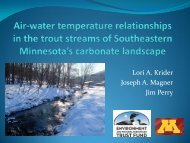Great Lakes Regional Water Program Great Lakes Regional Water
Great Lakes Regional Water Program Great Lakes Regional Water
Great Lakes Regional Water Program Great Lakes Regional Water
You also want an ePaper? Increase the reach of your titles
YUMPU automatically turns print PDFs into web optimized ePapers that Google loves.
National Theme Nutrient & Pesticide Management<br />
Nutrients and pesticides are potential pollutants of both surface and ground water. Pesticide and nutrient<br />
(fertilizer) use is almost ubiquitous across our developed and agricultural landscapes. Nutrients originate<br />
from a variety of sources including organic and inorganic fertilizers, plant parts, animal manures and<br />
human wastes. Likewise, pesticides are used for a wide range of purposes from disease, weed, and insect<br />
control in agricultural production systems to control of pests in urban lawns and landscapes. Proper<br />
handling, use, and disposal of these important and beneficial products are critical for preventing adverse<br />
impacts on water resources and aquatic habitats. The following story highlights efforts in the <strong>Great</strong> <strong>Lakes</strong><br />
Region to protect and improve water quality though research, education, and outreach efforts related to<br />
agricultural nutrient management<br />
<strong>Regional</strong> <strong>Program</strong>ming Success Story<br />
Integrating Phosphorus Indexes with National<br />
Nutrient Management Planning Software<br />
7<br />
SITUATION:<br />
The USEPA final Concentrated Animal Feeding Operations (CAFO) rule released in 2003 requires the development of<br />
nutrient management plans (NMPs) for approximately 18,000 large CAFOs by 2006. The USDA-Natural Resources<br />
Conservation Service generally requires livestock producers to develop and implement nutrient management planning as<br />
part of their cost-sharing programs, and recommends that all livestock producers (approximately 250,000) develop NMPs.<br />
As part of the nutrient management planning process in both the USEPA and NRCS programs, phosphorus (P) must be<br />
specifically addressed in NMPs, using either agronomic soil test P, soil P threshold values, or the P index (PI). All states in<br />
USEPA Region 5 have chosen some version of the phosphorus index as their tool of choice for developing P-based nutrient<br />
management plans. However, in USEPA Region 5, most PIs are either not fully developed or have not been released for use<br />
by the public. Illinois, Wisconsin and Minnesota do not currently have recommended PIs. Michigan and Ohio have spreadsheet<br />
versions of their PIs that must be used interactively, and the results of the PI are not linked to any other software used<br />
for writing and implementing NMPs. Indiana does have a preliminary risk assessment tool that is already linked to Manure<br />
Management Planner (MMP) software, but the final version is still under development. The target audiences for this effort<br />
include producers, technical service providers and NRCS. Land Grant Extension and regulatory agency personnel can all use<br />
MMP and MMPs risk assessment tools to streamline the nutrient management planning development and review process.<br />
15

















